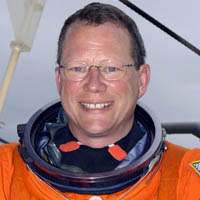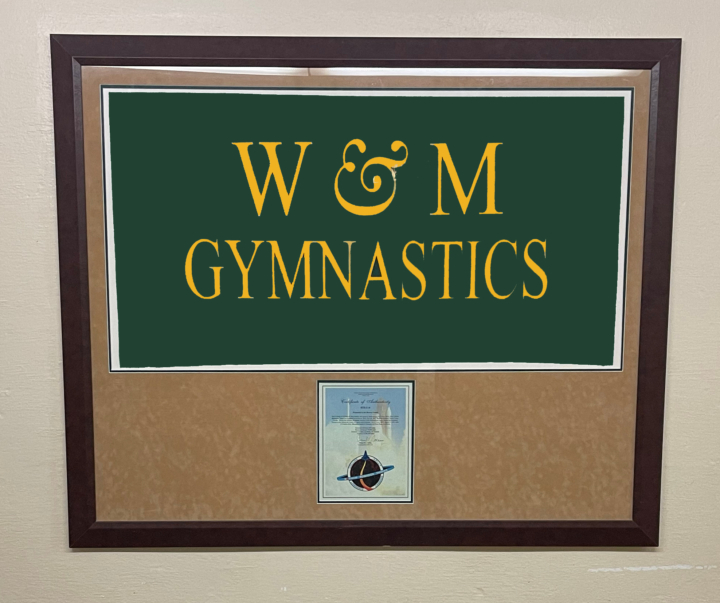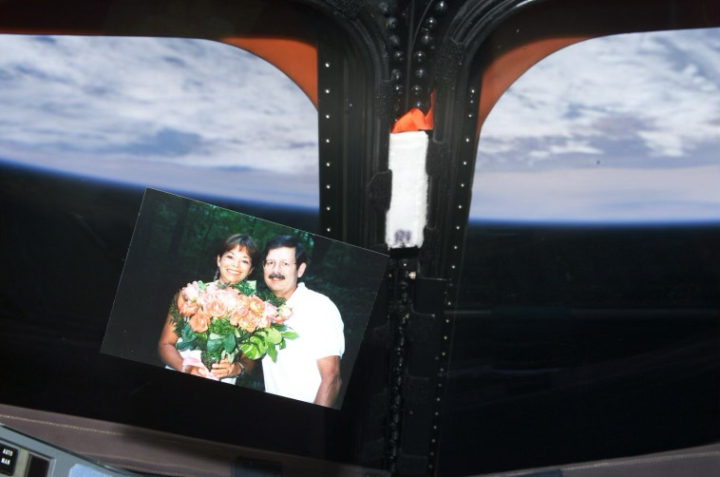On the ground floor of Kaplan Arena hangs a framed green banner with “W&M Gymnastics” in gold lettering. Below is a certificate of authenticity from NASA stating it had flown aboard Space Shuttle Discovery, which orbited the Earth 219 times and returned safely on Aug. 9, 2005.
But that isn’t the whole story.
Two and a half years earlier, a former William & Mary gymnast named David Brown ’78 was a mission specialist on the crew of Columbia. He asked Cliff Gauthier, his former coach, to help create a signed banner he could take on the trip. A little but significant piece of home so many miles away.

On Feb. 1, 2003, after nearly 16 days in space, Columbia disintegrated as it reentered the Earth’s atmosphere over Texas. All seven crew members perished.
In its return to flight in the summer of 2005, NASA reached out to Gauthier and told him how Brown had valued that banner. Gauthier was asked to send a duplicate for the Discovery trip and, of course, obliged.
That’s the banner that hangs on Kaplan’s ground floor, and that’s the story behind it. It’s particularly meaningful to Director of Gymnastics Mike Powell ’04, who as a W&M gymnast met Brown a few months before Columbia’s launch.
“Every recruit who comes through our door, we stop at that flag,” Powell said. “We talk with all the families and recruits regarding what our program is all about, and how Dave defined that in the way he lived. He was instrumental in developing the mission and philosophy we carry forward.

“Those are the kinds of people we want. Those who are going to make the most of the opportunity to not just be about the wins and losses and reaching their potential athletically but to keep a view on the bigger picture.”
Brown — gymnast, captain in the U.S. Navy, flight surgeon, aviator, astronaut — was all about the bigger picture.
Born in Arlington, Virginia, Brown was the youngest of two sons to Paul, a circuit judge, and Dorothy. As a child, he was obsessed with flying kites. Looking back, that was an obvious sign.
At William & Mary, he was among the first gymnasts to score in the 9s on the vault. The summer after his sophomore year, he performed as an acrobat, tumbler and stilt-walker in the circus.

While at W&M, he earned his pilot’s license at Williamsburg Jamestown Airport. After graduation, he and a friend, Gary Shelley ’72, flew across the country to Alaska in a four-seat Tri-Pacer. Frugal with their cash, they slept under the airplane’s wings.
“Dave was an incredible guy,” Shelley said. “He was extremely bright — I don’t have to tell you that. He had this intellectual curiosity about so many things, and flying was one of them.”
Then came Eastern Virginia Medical School, from which he earned his M.D. in 1982. He joined the Navy and completed flight surgeon training in 1984. In 1988, he was chosen for pilot training and became a Naval Aviator two years later.
“He said one of the most intimidating and exciting experiences he ever had was landing a jet on an aircraft carrier in rough seas at night,” Gauthier said.
In 1996, Brown was selected by NASA and reported to Johnson Space Center in Houston. After two years of training, he qualified as a mission specialist. Then came Columbia in 2003, when he spent nearly 16 days in space.

On Feb. 3, 2004, a year and two days after the tragedy, U.S. President George W. Bush awarded all seven crew members the Congressional Space Medal of Honor. Brown also was the first person to posthumously be given the William & Mary Alumni Association’s Alumni Medal.
Brown was only 46 when he died, but those were 46 fruitful years.
“He had four goals in his planner,” said Gauthier, the men’s gymnastics coach from 1973-2016. “The first was to always burn brightly within his circle of influence. The second was to love. The third was to learn. And the fourth was to leave a legacy. Those are what drove him.
“His death precipitated me to re-examine the mission and values of our gymnastics program. As I started doing that, those missions and values very much paralleled the core values of a life well lived. And Dave Brown was simply a life well lived.”
On Aug. 30, 2002, four-and-a-half months before Columbia’s launch, Brown was invited to speak at his alma mater’s Opening Convocation. In addressing the risks astronauts face, he made a comparison to James Blair’s efforts to establish William & Mary in 1693.
“James Blair made a total of 11 crossings across the Atlantic Ocean dedicated to the university, to its ongoing support, to its financial health,” Brown said that day. “I don’t know what the odds are for that. But I think (with) my ride in the space shuttle, I’ve got a better chance of making that than he did back then.”
Even if the unthinkable were to happen, Brown believed the mission should endure. In an interview with CNN on the day of the tragedy, Dorothy recalled a conversation between David and his brother, Doug.
“Doug, who is two years older, asked David, ‘What if you were to die?'” Dorothy said. “And Dave just said, ‘This program will go on. It has to go on.'”
Gauthier and his wife, Linda, attended the launch at the Kennedy Space Center on Jan. 16, 2003. Weeks before, Brown had asked Cliff for a picture of the two. He found one taken on their 25th anniversary and gave it to Brown. A few days into the flight,
Gauthier received an email from Brown.
It was a photo of that snapshot floating in the shuttle with the Earth’s horizon through a window in the background. Today, it’s the wallpaper on Gauthier’s phone.

Brown sent several emails to Gauthier from Columbia. It was clear he loved what he was doing. On his 15th day in space, he wrote:
“The views of the Earth are really beautiful. What really amazes me is seeing large geographic features with my own eyes. Today, I saw all of Northern Libya, the Sinai Peninsula, the whole country of Israel, and then the Red Sea. I wish I’d had more time just to sit and look out the window with a map but our science program kept us very busy in the lab most of the time.
“If I’d been born in space I know I would desire to visit the beautiful Earth more than I’ve ever yearned to visit space. It is a wonderful planet.”
Brown certainly did his part to make it that way.

